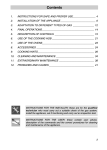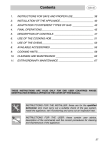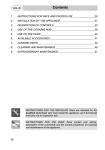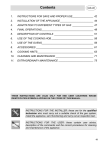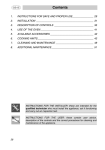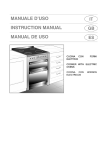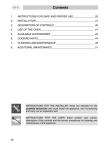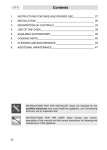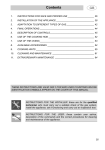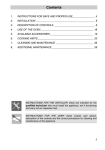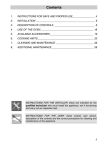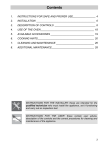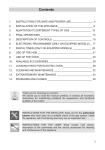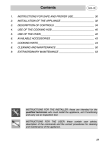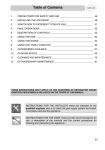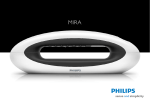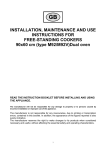Download Smeg A3 User's Manual
Transcript
Contents 1. INSTRUCTIONS FOR SAFE AND PROPER USE _______________40 2. INSTALLATION OF THE APPLIANCE ________________________42 3. ADAPTATION TO DIFFERENT TYPES OF GAS ________________45 4. FINAL OPERATIONS______________________________________47 5. DESCRIPTION OF CONTROLS _____________________________49 6. USE OF THE COOKING HOB _______________________________55 7. USE OF THE OVENS _____________________________________57 8. ACCESSORIES __________________________________________58 9. COOKING HINTS _________________________________________60 10. CLEANING AND MAINTENANCE ____________________________68 11. EXTRAORDINARY MAINTENANCE __________________________72 THESE INSTRUCTIONS ARE VALID ONLY FOR END USER COUNTRIES WHOSE IDENTIFICATION SYMBOLS APPEAR ON THE COVER OF THIS MANUAL. INSTRUCTIONS FOR THE INSTALLER: these are for the qualified technician who must carry out a suitable check of the gas system, install the appliance, set it functioning and carry out an inspection test. INSTRUCTIONS FOR THE USER: these contain user advice, description of the commands and the correct procedures for cleaning and maintenance of the appliance. 39 Introduction 1. INSTRUCTIONS FOR SAFE AND PROPER USE THIS MANUAL IS AN INTEGRAL PART OF THE APPLIANCE AND THEREFORE MUST BE KEPT IN ITS ENTIRETY AND IN AN ACCESSIBLE PLACE FOR THE WHOLE WORKING LIFE OF THE COOKER. WE ADVISE READING THIS MANUAL AND ALL THE INSTRUCTIONS THEREIN BEFORE USING THE COOKER. ALSO KEEP THE SERIES OF NOZZLES SUPPLIED. INSTALLATION MUST BE CARRIED OUT BY QUALIFIED PERSONNEL IN ACCORDANCE WITH THE REGULATIONS IN FORCE. THIS APPLIANCE IS INTENDED FOR DOMESTIC USES AND CONFORMS TO CURRENT REGULATIONS IN FORCE. THE APPLIANCE HAS BEEN BUILT TO CARRY OUT THE FOLLOWING FUNCTIONS: COOKING AND HEATING-UP OF FOOD. ALL OTHER USES ARE CONSIDERED IMPROPER. THE MANUFACTURER DECLINES ALL RESPONSIBILITY FOR IMPROPER USE. DO NOT LEAVE THE PACKING IN THE HOME ENVIRONMENT. SEPARATE THE VARIOUS WASTE MATERIALS AND TAKE THEM TO THE NEAREST SPECIAL GARBAGE COLLECTION CENTRE. IT IS OBLIGATORY FOR THE ELECTRICAL SYSTEM TO BE GROUNDED ACCORDING TO THE METHODS REQUIRED BY SAFETY RULES. IMMEDIATELY AFTER INSTALLATION CARRY OUT A BRIEF INSPECTION TEST OF THE APPLIANCE, FOLLOWING THE INSTRUCTIONS BELOW. SHOULD THE APPLIANCE NOT FUNCTION, SWITCH OFF THE POWER SUPPLY TO THE APPLIANCE AND CALL THE NEAREST TECHNICAL ASSISTANCE CENTRE. NEVER ATTEMPT TO REPAIR THE APPLIANCE. ALWAYS CHECK THAT THE CONTROL KNOBS ARE IN THE POSITION (OFF) WHEN YOU FINISH USING THE HOB. NEVER PUT INFLAMMABLE OBJECTS INTO AN OVEN: IF THEY CATCH FIRE THEY COULD CAUSE A FIRE IN THE HOME. THE I.D. PLATE WITH TECHNICAL DATA, REGISTRATION NUMBER AND BRAND NAME IS POSITIONED VISIBLY IN THE STORAGE COMPARTMENT. THE PLATE MUST NOT BE REMOVED. 40 Introduction DURING USE THE APPLIANCE BECOMES VERY HOT. TAKE CARE NOT TO TOUCH THE HEATING ELEMENTS INSIDE THE OVEN. DO NOT INSTALL THIS APPLIANCE ON A RAISED PLATFORM DO NOT PUT PANS WITHOUT PERFECTLY SMOOTH AND FLAT BOTTOMS ON THE COOKING HOB GRIDS. DO NOT USE CONTAINERS OR BROILERS THAT EXTEND BEYOND THE OUTER PERIMETER OF THE HOB. THE APPLIANCE IS DESIGNED FOR USE BY ADULTS. DO NOT ALLOW CHILDREN TO GO NEAR OR PLAY WITH IT. REPLACED APPLIANCES MUST BE TAKEN TO A SPECIAL GARBAGE COLLECTION CENTRE. The manufacturer declines all responsibility for damage to persons or things caused by non-observance of the above prescriptions or by interference with any part of the appliance or by the use of non-original spares. 41 Instructions for the installer 2. INSTALLATION OF THE APPLIANCE It is the law that all gas appliances are installed by competent persons. Corgi gas installers are approved to work to safe and satisfactory standards. All gas installation, servicing and repair work must be in accordance with the gas safety regulations 1984 (installation and use) as amended 1990. It can be placed against walls higher than the hob, at a distance of at least 50 mm from the side of the appliance, as shown in the drawings A and B relating to the installation classes. Wall units or extractor hoods located above the hob must be at least 750 mm away from it. A B SLOT IN FREE STANDING 2.1 Positioning and levelling of the appliance This appliance is fitted with 4 castors for easy positioning. To block the appliance in tis final position, extract the feet on the front and screw the corresponding castors in. CAUTION: delicate floors could be damaged by the castors; in this case, lift the appliance with a mechanical means. 2.2 Electrical connection Make sure that the power line voltage matches the specifications indicated on the rating plate located inside the storage compartment. This rating plate must never be removed. The connection to the mains shall be done conforming to the regulations in force. Check that the power line is adequately grounded. Do not use reducers, adapters or shunts. On the power line, install an omnipolar cutoff device with contact cut-off distance greater than or equal to 3 mm, located in an easily accessible position near the unit. 42 Instructions for the installer The connection terminals are located at the rear of the appliance. For electrical connections see following diagram. To access, remove the rear cover. For operation on 400-415V3N∼: use an H05RR-F-type five-core cable (5 x 2 1.5 mm ). For operation on 400-415V2N∼: use an H05RR-F-type four-core cable (4 x 2 2.5 mm ). For operation on 230-240V∼: use an H05RR-F-type three-core cable (3 x 4 2 mm ). The cable end to be connected to the appliance must be provided with an ground wire (yellow-green) at least 20 mm longer. The manufacturer declines all responsibility for damage to persons or things caused by non-observance of the above prescriptions or by interference with any part of the appliance. 43 Instructions for the installer 2.3 Ventilation requirements The room containing the appliance should have an air supply in accordance with B.S. 5440 part 2 1989. 1. All rooms require an opening window or equivalent, and some rooms will require a permanent vent as well. 3 2 2. For room volumes up to 5 m an air vent of 100 cm is required. 3. If the room has a door that opens directly to the outside, and the 3 room exceeds 1 m no air vent is required. 3 3 2 4. For room volumes between 5 m and 10 m an air vent of 50 cm is required. 5. If there are other fuel burning appliances in the same room B.S. 5440 part 2 1989 should be consulted to determine the air vent requirements. 6. This appliance must not be installed in a bed sitting room of less 3 than 20 m or in a bathroom or shower room. Windows and permanent vents should therefore not be blocked or removed without first consulting a Corgi gas installer. Failure to install appliances correctly is dangerous and could lead to prosecution. 2.4 Connecting to natural and LPG gas (Please see connection diagram) Make the connection to the appliance using flexible bayonet style hose in accordance to B.S. 669. The hose connection at the rear of the appliance has a 1/2" BSP internal thread. Please use seal C between the flexible connection L and the appliance supply tube B. When making the connection, make sure that no stress of any kind is applied to the cooker and that the hose does not touch any sharp edges or come in contact with the rear of the appliance. If connecting to LPG the bayonet hose must have red bands on it. 44 Instructions for the installer 3. ADAPTATION TO DIFFERENT TYPES OF GAS Before performing any cleaning or maintenance work, switch off the power supply to the appliance. The cooking hob of the cooker is preset for G20 natural gas at a pressure of 20 mbar. In the case of functioning with other types of gas the burner nozzles must be changed and the minimum flame adjusted on the gas taps. Replace the burner nozzles as indicated in the table of the gas to be used. 3.1 Changing nozzles 1. 2. 3. Extract the grids and remove all the caps and flame-spreader crowns; unscrew the burner nozzles with a 7 mm socket wrench; proceed with replacing the burner nozzles in accordance with the table for the gas in question. 45 Instructions for the installer 3.2 Burner and nozzle characteristics table Burner Auxiliary Semi rapid Rapid Fish Burner Triple crown Burner Rated heating capacity (kW) 1.05 1.8 3.0 1.9 3.3 LPG – G30/G31 28/37 mbar (drawing ref. X238) Nozzle diameter 1/100 mm By-pass Mm 1/100 Reduced flowrate (W) Flowrate g/h G30 Flowrate g/h G31 50 65 85 68 91 30 33 45 45 68 360 450 750 800 1600 76 131 218 138 218 75 129 215 136 215 Rated heating capacity (kW) NATURAL GAS – G20 20 mbar Auxiliary 1.05 Nozzle diameter 1/100 mm 72 Semi rapid Rapid Fish Burner Triple crown 1.8 3.0 1.9 3.5 97 115 94 133 Drawing Ref. (X) Reduced flowrate (W) 360 (Z) (Y) (X) (S) 450 750 800 1600 3.3 Arrangement of burners on cooking hob BURNERS 1 2 3 4 5 46 Auxiliary Semi rapid Rapid Triple crown Fish burner Instructions for the installer 4. FINAL OPERATIONS After replacing the nozzles, reposition the flame-spreader crowns, the burner caps and the grids. Following adjustment to a gas other than the preset one, replace the gas adjustment label fixed to the appliance with the one corresponding to the new gas. This label is in the packet together with the nozzles. 4.1 Adjustment of minimum for natural gas Light the burner and turn it to the minimum position . Extract the gas tap knob and turn the adjustment screw at the side of the tap rod until the correct minimum flame is achieved. Replace the knob and check burner flame stability: (rapidly turning the knob from maximum to minimum position, the flame should not go out). Repeat the operation on all the gas taps. 4.2 Regulation of minimum for LPG For regulating the minimum with LPG, the screw at the side of the tap rod must be turned clockwise all the way. The bypass diameters for each individual burner are shown in paragraph “3.2 Burner and nozzle characteristics table”. When adjustment is complete, re-seal the by-passes using wax or an equivalent material. 47 Instructions for the installer 4.3 • • 48 Mounting the rear top upstand Position the upstand above the top, taking care to align holes A with holes B. Secure the upstand to the top by tightening screws C. Instructions for the user 5. DESCRIPTION OF CONTROLS 5.1 Front control panel All the cooker controls and commands are on the front panel. Before using the main oven check that the electronic programmer is showing the symbol (see paragraph “5.2.1 Clock adjustment”). DESCRIZIONE DEI SIMBOLI FRONT LEFT BURNER BACK LEFT BURNER FRONT CENTRAL BURNER BACK CENTRAL BURNER FRONT RIGHT BURNER BACK RIGHT BURNER BARBECUE ELEMENT MAIN OVEN THERMOSTAT AUXILIARY OVEN THERMOSTAT MAIN OVEN FUNCTIONS AUXILIARY OVEN FUNCTIONS COOKING HOB BURNER COMMAND KNOB The flame is lit by pressing the knob and turning it anticlockwise to maximum flame . To adjust the flame turn the knob between maximum ( ) and minimum ( ). The burner goes out when the knob is returned to the position . 49 Instructions for the user MAIN OVEN THERMOSTAT KNOB Selection of cooking temperature is carried out by turning the knob clockwise to the required temperature, between 50° and 250°C. The tell-tale light comes on to indicate that the oven is warming up. When it goes out it means that the required temperature has been reached. Intermittent going on and off of the light means that the oven temperature is being constantly maintained at the programmed level. AUXILIARY OVEN VARIABLE GRILL KNOB Position the auxiliary oven thermostat knob on the symbol or . Turn the variable grill knob clockwise to the desired position. When the signal light comes on the grill is engaged. BARBECUE ELEMENT POWER REGULATOR KNOB This knob allows adjustment of the power of the barbecue griddle on the hob. Set the knob on any position from “1” to “9” to turn on the heating element. The pilot light illuminates to indicate that the element is in operation. To switch off the element, turn the knob to “0”. CAUTION: after it has been in operation for some time, the plate will remain hot even after the element has been switched off: keep children at a safe distance. 50 Instructions for the user MAIN OVEN FUNCTION SWITCH KNOB Turn the knob to select from the following functions: NO FUNCTION SET OVEN LIGHT GRILL ELEMENT + VENTILATION UPPER AND LOWER HEATING ELEMENT LOWER HEATING ELEMENT + VENTILATED HEATING ELEMENT VENTILATED HEATING ELEMENT + VENTILATION GRILL ELEMENT AUXILIARY OVEN THERMOSTAT KNOB Selection of cooking temperature is carried out by turning the knob clockwise to the required temperature, between 50° and 220°C. The tell-tale light comes on to indicate that the oven is warming up. When it goes out it means that the required temperature has been reached. Intermittent going on and off of the light means that the oven temperature is being constantly maintained at the programmed level. The oven is switched on by turning the knob clockwise to any one of the following functions except the oven light: NO FUNCTION SET LOWER HEATING ELEMENT OVEN LIGHT GRILL ELEMENT (spit) UPPER AND LOWER HEATING ELEMENT (between 50° and 220°C) UPPER HEATING ELEMENT + GRILL ELEMENT 51 Instructions for the user 5.2 Electronic Programmer The programmer user instructions are valid only for the main oven. LIST OF FUNCTIONS MINUTE-COUNTER KEY COOKING TIME KEY END-OF-COOKING KEY DECREASE TIME KEY INCREASE TIME KEY 5.2.1 Clock adjustment When using the oven for the first time, or after a power failure, the display flashes regularly and indicates . Press the keys and at o : each single press changes the time by 1 the same time the keys minute either up or down. Before setting the programmer activate the desired function and temperature. 52 Instructions for the user 5.2.2 Semiautomatic cooking Use this setting for automatic oven switch-off at the end of cooking time. , the display lights up, showing ; keep the key By pressing key pressed and at the same time, press keys o to set the cooking time. Release key to start the programmed cooking time count. The display will now show the right time together with symbols A and . 5.2.3 Automatic cooking Use this setting to automatically start and stop the oven. By pressing key , the display lights up showing ; keep the key pressed and at the same time, press keys or to set the cooking time. By pressing key the sum of the right time + cooking time will appear; keep the key pressed and at the same time, press keys o to regulate the end of cooking time. Release key to start the programmed count and the display will show the right time together with symbols A and . After set-up, to see the cooking time remaining, press the key ; to see the end of cooking time press the key . Set-up with incoherent values is logically prevented (e.g. the contrast between a cooking time and a longer period will not be accepted by the programmer). 5.2.4 End of cooking When cooking is over, the oven will automatically switch off and, at the same time, an intermittent alarm will sound. After switching off the alarm, the display will once again show the right time together with the symbol , indicating that the oven has returned to manual operation mode. 53 Instructions for the user 5.2.5 Adjusting alarm volume The acoustic alarm has three different settings. These can be operated, . while the alarm is sounding, by pressing key 5.2.6 Switching off the alarm The alarm switches off automatically after seven minutes. They can be manually de-activated by pressing the keys and together. 5.2.7 Minute Counter The programmer can also be used as a simple minute counter. By pressing key , the display shows ; keep the key pressed and at the same time press keys o . On releasing the key , programmed counting will begin and the display will show the current time and the symbol . After set-up, to see the remaining time, press the key . Use as a minute counter does not interrupt functioning of the oven at the end of the programmed time. 5.2.8 Cancellation of set data Once the programme has been set, keep the key of the function to be is reached by means cancelled pressed, while at the same time of variation keys o . Time cancellation will be considered as end-ofcooking time by the programmer. 5.2.9 Changing the set data The cooking data entered can be changed at any time by keeping the function key pressed and at the same time adjusting the keys o . 54 Instructions for the user 6. USE OF THE COOKING HOB 6.1 Lighting of the cooking hob burners Before lighting the cooking hob burners check that the flame cap crowns are properly positioned with their appropriate burner caps: niche A must be centred with pin B. Grid C should be used with Chinese woks. Each knob corresponds to the burner indicated. The appliance is equipped with an electronic lighting device. Just press and turn the knob until the burner lights. anticlockwise to the maximum flame symbol Keep the knob pressed for about 2 seconds to let the thermocouple heat up. If the burner turns off when the knob is released, it means that the thermocouple isn’t hot enough. Repeat ignition and keep the knob pressed longer. If the burners turn off accidentally, a safety device will trip after about 20 seconds to cut off gas flow (even with the gas tap open). 55 Instructions for the user 6.2 Practical advice for using the cooking hob burners For better use of the burners and lower gas consumption, use covered containers that are proportional in size to the burner to prevent the flame from licking the sides (see paragraph “0 Diameter of containers”). When water reaches the boiling point, lower the flame so that it doesn’t overflow. To avoid burns or damage to the hob, all recipients or griddle plates must be placed within the perimeter of the cooking hob. All containers have to have a flat and smooth bottom. When using fats or oils, be extremely careful that they don’t overheat and catch fire. If the flame accidentally goes out, turn off the control knob and wait at least 1 minute before trying to re-light the burner. 6.3 Diameter of containers BURNERS 1 2 3 4 5 Auxiliary Semi rapid Rapid Ultra rapid Fish Burner Ø min. e max. (in cm) 12-14 16-20 18-24 20-24 Special ovalshaped vessels 6.4 Using the griddle plate The griddle plate is coated with a thin film of non-stick material (Teflon). This film is very delicate and could be damaged or scratched by any metal cooking tool. Use only wooden or heat resistant plastic tools. 56 Instructions for the user 7. USE OF THE OVENS 7.1 Warnings and general advice Before using the oven for the first time, pre-heat it to maximum temperature (250°C) long enough to burn any manufacturing oily residues which could give the food a bad taste. After a power failure, the display will flash at regular intervals showing . To regulate, refer to paragraph “5.2 Electronic Programmer”. During cooking, do not cover the bottom of the oven with aluminium or tin foil and do not place pans or oven trays on it as this may damage the enamel coating. If you wish to use greaseproof paper, place it so that it will not interfere with the hot air circulation inside the oven. To prevent any steam in the oven creating problems, open the door in two stages: half open (5 cm approx.) for 4-5 seconds and then fully open. To access food, always leave the door open as short a time as possible to prevent the temperature in the oven from falling and ruining the food. 7.2 Oven Light It comes on when the function switch knob is turned to any position. 7.3 Storage compartment A storage compartment, accessible by pulling on the top edge of the door, is located beneath the ovens. Never store inflammable materials such as rags, paper or the like. The compartment is intended only for holding the metal accessories of the range. Never open the storage compartment when the oven is on and still hot. The temperature inside may be very high. 57 Instructions for the user 8. ACCESSORIES The oven features 4 support positions for plates and racks of different height. Oven grill: for cooking food on plates, small cakes, roasts or food requiring light grilling. Plate grill: for placing above plate for cooking foods that might drip. Oven plate: useful for catching fat from foods on the grill above. Pastry plate: for baking cakes, pizza and oven desserts. Roasting spit: useful for cooking chicken, sausages and anything else requiring uniform cooking over the whole surface. Only for auxiliary oven. Main oven rotisserie frame: to be fitted into the holes provided in the oven dish. Spit Frame: to be inserted in the guides of the auxiliary oven before using the spit. 58 Instructions for the user Accessories on Request You can order the lower base and self-cleaning oven panels through Authorised Assistance Centres. Two optional accessories are also available from Authorised Service Centres: Griddle plate on gas burner: this optional plate is for installation on the hob instead of the right-hand pan stand (fish burner). Take care that the feet of the griddle plate are resting firmly on the base of the hob to prevent the risk of tipping. Barbecue grille: this open grille is for installation on the barbecue element instead of the aluminium plate. 59 Instructions for the user 9. COOKING HINTS In fan-assisted mode preheating should be carried out at 30/40°C above the cooking temperature. This considerably shortens cooking times and reduces power consumption, as well as giving better cooking results. Keep the oven door closed during cooking 9.1 Traditional cooking (main and auxiliary ovens) FUNCTION SWITCH THERMOSTAT SELECTOR SWITCH FROM 50° TO 250°C THERMOSTAT SELECTOR SWITCH FROM 50° TO 220°C This traditional cooking method, in which heat comes from above and below, is suitable for cooking food on a single level. You have to preheat the oven until the set temperature is reached. Place the food in the oven only after the thermostat indicator light has turned off. very fatty meats may be put in when the oven is still cold. Put frozen meat in immediately, without waiting for it to thaw. The only precaution you need to take is to set the temperature about 20°C lower and cooking time about 1/4 longer than you would for fresh meat. Use high-rim pans to prevent fat splashing and dirtying the sides of the oven. 60 Instructions for the user 9.2 Hot-air cooking (main oven) FUNCTION SWITCH THERMOSTAT SELECTOR SWITCH FROM 50° TO 250°C This system is suitable for cooking on several levels, including different types of food (fish, meat etc.), without the tastes and smells mingling. Air circulation in the oven ensures a uniform distribution of heat. Pre-heating is not necessary. Multiple cooking is possible as long as the cooking temperature of the different foods is the same. 9.3 Grill cooking (main oven) FUNCTION SWITCH THERMOSTAT SWITCH AT MAXIMUM Permits rapid browning of foods. You are advised to place the pan in the highest guide. For short-term cooking of small quantities, place the grid in the third guide from the bottom. For long-term cooking and grills, put the grid in the lowest guide in accordance with the size of the pieces. Keep the oven door closed during cooking. 61 Instructions for the user 9.4 Hot-air grilling (main oven) FUNCTION SWITCH THERMOSTAT SWITCH FROM 50° TO 200°C Ensures uniform heat distribution with greater heat penetration into the food. Food will be lightly browned on the outside and remain soft inside. Keep the oven door closed during cooking. Heating up time must not exceed 60 minutes. 9.5 Variable grill cooking (auxiliary oven) THERMOSTAT SWITCH IN POSITION VARIABLE GRILL CHOICE BETWEEN MIN. AND MAX. This function permits varying the power of the grill according to the quantity of food to be cooked. Position the auxiliary oven thermostat knob on the symbol or . Turn the variable grill knob clockwise to the desired position. When the signal light comes on the grill is engaged. Keep the oven door closed during cooking. 62 Instructions for the user 9.6 Delicate cooking (auxiliary oven) FUNCTION SWITCH THERMOSTAT SWITCH AT MAXIMUM Ideal for pastries and cakes with wet covering and little sugar and damp desserts in moulds. Excellent results can also be achieved in completing cooking at the bottom and with dishes requiring heat in the lower area in particular. The plate is best inserted at bottom level. 9.7 Defrosting (main oven) FUNCTION SWITCH THERMOSTAT SWITCH IN POSITION 0 The flow of air produced by the fan ensures quicker defrosting. The air circulating inside the oven is at room temperature. The advantage of defrosting at room temperature is that it does not alter the taste and appearance of the food. 63 Instructions for the user 9.8 Spit cooking (main oven) FUNCTION SWITCH THERMOSTAT SWITCH FROM 50° TO 200°C Prepare the spit with the food, blocking fork screws A. Insert frame B into the third guide from the bottom. Remove handle D and position the spit shaft so that pulley E is guided on the link of frame B in the right side. Insert the drip tray into the oven as far as it will go until the tip of the rod is in line with the hole C. Now rock the frames B to insert the tip of the rod into the drive connection C of the rotisserie motor on the side of the oven. Pour a bit of water into the pan to avoid smoke from the dripping. Keep the oven door closed during cooking. It is normal for the thermostat light to go on and off intermittently during cooking. This indicates the temperature inside the oven is regular. CAUTION: the frames B must be fitted as shown in the diagram 64 Instructions for the user 9.9 Spit cooking (auxiliary oven) FUNCTION SWITCH VARIABLE GRILL CHOICE BETWEEN MIN. AND ¾ MAX Use it for small size pieces. Prepare the spit with the food, blocking fork screws A. Insert frame B into the third guide from the bottom. Remove handle D and position the spit shaft so that pulley E is guided on the link of frame B. Fully insert frame B until the point of the spit shaft enters the spit-turning motor housing C on the rear wall of the oven. Position pan F on the lowest guide and pour a little water in to avoid smoke forming. Keep the oven door closed during cooking. It is normal for the thermostat light to go on and off intermittently during cooking. This indicates the temperature inside the oven is regular. 65 Instructions for the user 9.10 Recommended cooking table Cooking times, especially meat, vary according to the thickness and quality of the food and to consumer taste. TRADITIONAL COOKING FIRST COURSES LASAGNE OVEN-BAKED PASTA MEAT ROAST VEAL ROAST BEEF ROAST PORK CHICKEN DUCK GOOSE - TURKEY RABBIT LEG OF LAMB ROAST FISH PIZZA DESSERTS MERINGUE SHORT PASTRY CIAMBELLA SAVOYARDS BRIOCHES FRUIT CAKE LEVEL FROM BELOW TEMPERATURE (°C) TIME IN MINUTES (*) 2-3 2-3 210 - 230 210 - 230 30 40 2 2 2 2 2 2 2 1 1-2 170 - 200 210 - 240 170 - 200 170 - 200 170 - 200 140 - 170 170 - 200 170 - 200 170 - 200 1-2 210 - 240 30 - 40 / KG. 30 - 40 / KG. 30 - 40 / KG. 45 - 60 45 - 60 45 - 60 50 - 60 15 / KG. ACCORDING TO DIMENSIONS 40 - 45 1-2 1-2 1-2 1-2 1-2 1-2 50 - 70 170 - 200 165 150 170 - 200 170 - 200 60 - 90 15 - 20 35 - 45 30 - 50 40 - 45 20 - 30 (*) = WITH PREHEATED OVEN GRILLING LEVEL FROM BELOW PORK CHOPS FILLET OF PORK FILLET OF BEEF LIVER VEAL ESCALOPES HALF CHICKEN SAUSAGES MEAT-BALLS FISH FILLETS TOAST 66 4 3 3 4 4 3 4 4 4 4 TIME IN MINUTES FIRST SURFACE 7-9 9 - 11 9 - 11 2-3 7-9 9 - 14 7-9 7-9 5-6 2-4 SECOND SURFACE 5-7 5-9 9 - 11 2-3 5-7 9 - 11 5-6 5-6 3-4 2-3 Instructions for the user HOT-AIR COOKING FIRST COURSES LASAGNE OVEN-BAKED PASTA CREOLE RICE MEAT ROAST VEAL ROAST PORK ROASTED BEEF FILLET OF BEEF ROAST LAMB ROAST BEEF ROAST CHICKEN ROAST DUCK ROAST TURKEY ROAST RABBIT ROAST HARE ROAST PIGEON FISH PIZZA DESSERTS (PASTRIES) CIAMBELLA FRUIT CAKE SPONGE-CAKE BRIOCHES STRUDEL SAVOYARD PUDDING BREAD TOAST LEVEL FROM BELOW TEMPERATURE (°C) TIME IN MINUTES 2 2 2 190 - 210 190 - 210 190 - 220 20 - 25 25 - 30 20 - 25 2 2 2 2 2 2 2 2 2 2 2 2 2-3 150 - 170 150 - 160 160 - 170 160 - 180 130 - 150 170 - 180 170 160 - 170 150 - 160 150 - 160 160 - 170 140 - 170 150 - 170 2-3 210 - 240 65 - 90 70 - 100 65 - 90 35 - 45 100 - 130 40 - 45 70 - 90 100 - 160 160 - 240 80 - 100 30 - 50 15 - 25 ACCORDING TO DIMENSIONS 30 - 50 2-3 2-3 2-3 2-3 1-2 2-3 2-3 1-2 150 - 170 170 - 190 190 - 220 160 - 170 150 160 - 170 190 - 210 220 - 240 35 - 45 40 - 50 25 - 35 40 - 60 25 - 35 30 - 40 40 7 When cooking with the barbecue griddle, it should be left to heat up for about 15 minutes. 67 Instructions for the user 10. CLEANING AND MAINTENANCE 10.1 Cleaning stainless steel To keep stainless steel in good condition it should be cleaned regularly after use. Let it cool first. 10.1.1 Ordinary Daily Cleaning To clean and preserve the stainless steel surfaces, always use only specific products that do not contain abrasives or chlorine-based acids. How to use: pour the product on a damp cloth and wipe the surface, rinse thoroughly and dry with a soft cloth or deerskin. 10.1.2 Food stains or residues Do not use metallic sponges or sharp scrapers: they will damage the surface. Use normal non-abrasive products for steel, and a wooden or plastic tool if necessary. Rinse thoroughly and dry with a soft cloth or deerskin. Do not allow residues of sugary foods (such as jam) to set inside the oven. If left to set for too long, they might damage the enamel lining of the oven. 10.2 Cleaning of cooking hob components 10.2.1 Barbecue griddle Extract the griddle from its seat (after leaving it to cool) by lifting it from the front as shown in the diagram and taking care not to spill the residues which have collected in the grooves at the sides. Clean it with an ordinary detergent and a non-abrasive sponge. 68 Instructions for the user 10.2.2 Barbecue drip tray To remove the drip tray under the barbecue element: 1. Remove the griddle as described in point 10.2.1; 2. Raise the heating element and fix it in place by sliding the retainer to the right (as shown in the adjacent diagram); 3. Remove the drip tray using the two handles and clean using specific detergents for stainless steel and a non-abrasive sponge. 10.2.3 Grids Remove the right-hand pan stands (griddle + fish burner) as shown in the diagram. There is no special order for removal of the left-hand pan stands. Clean the pan stands in warm water and non-abrasive detergent, taking care to remove all deposits. Replace, fitting first the outside pan stand then the griddle. 10.2.4 Burner caps, flame cap crowns and burners The burner caps, flame cap crowns and burners are extractable to facilitate cleaning. Wash them with hot water and non-abrasive detergent, taking care to remove incrustation, and leave them to dry completely. Reassemble the burner caps on their crowns, ensuring that niches A are centred with burner pins B. 69 Instructions for the user 10.2.5 Ignition plugs and thermocouples To work well, the ignition plugs and thermocouples must always be very clean. Check them frequently and clean them with a wet rag if necessary. Any dry residue should be removed with a toothpick or a needle. 10.3 Cleaning of ovens (without self-cleaning panels) To keep an oven in good condition it must be cleaned regularly. Let it cool first. Take out all the removable parts. In the main oven, remove the shelf runners by unscrewing the ring-nut “A” and extract them from the runner “B” by pulling outward. (Fig. 1) In the auxiliary oven, remove the shelf runners by lifting them at the front and extracting them from their rear holes. (Fig. 2) • • Clean the oven grill and side guides with hot water and non-abrasive detergent. Rinse and dry. Clean the internal walls of the oven with a soft ammoniac-soaked cloth. Rinse and dry. If there are still stains or drops, place a damp ammoniac-soaked cloth on the bottom of the oven, close the door and after a few hours wash the oven with hot water and liquid detergent. Rinse and dry. 10.3.1 Self-cleaning liners The main oven is equipped with continuous self-cleaning enamelled liners. These liners make the oven easier to clean and ensure its efficiency over time. 70 Instructions for the user 10.3.2 Using the self-cleaning liners Periodically, to prevent food residues and unpleasant smells from accumulating inside the oven, the appliance should be operated empty at temperatures of not less than 200°C for a time varying from 30 to 60 minutes, in order to allow the self-cleaning liners to oxidise the residues present; when the oven has cooled, these will then be removed with a damp sponge 10.3.3 Looking after the self-cleaning liners The liners should not be cleaned with abrasive creams or ordinary detergents. Use a damp sponge only, so as not to damage the special characteristics of the enamel which coats the liners. 10.3.4 1. 2. 3. 4. 5. Assembling the self-cleaning liners Remove all accessories from the oven; Remove the side grilles (fig.1); Extract the side liners “F” and “G”(fig. 2); Remove the back panel “A” after undoing the threaded ring-nut “C” (fig. 2). Reassemble the panels, restoring them to their original position. 1) 2) 10.4 Door glass These should always be kept very clean. Use absorbent kitchen paper or, in case of hard to remove dirt, wash with a wet sponge and ordinary detergent. 71 Instructions for the user 11. EXTRAORDINARY MAINTENANCE Ovens periodically require small maintenance interventions or replacement of parts subject to wear and tear such as gaskets, electric bulbs etc. Specific instructions for each intervention of this type appear below. Before performing any operations requiring access to powered parts, switch off the power supply to the machine. 11.1 Replacement of light bulbs Remove cover A by twisting anticlockwise, replace bulb B with another similar bulb. Refit the cover A. Only use oven bulbs (T 300°C). 72 Instructions for the user 11.2 Dismantling of the doors Hold the door on both sides with both hands near hinges A and raise levers B. Lift up the door forming an angle of about 45° and remove. To refit, slide the hinges A in the grooves, drop the door and release levers B. 11.3 Oven door gaskets The door gaskets can be dismantled for thorough cleaning of the ovens. Before removing the gaskets the oven doors must be removed as previously described. With the doors removed, raise the tabs at the corners as shown in the figure. 11.4 Lubrication of gas taps With time it may happen that the gas taps get blocked and hard to turn. Clean them inside and re-grease them. This operation must be done by a specialised technician. 73




































